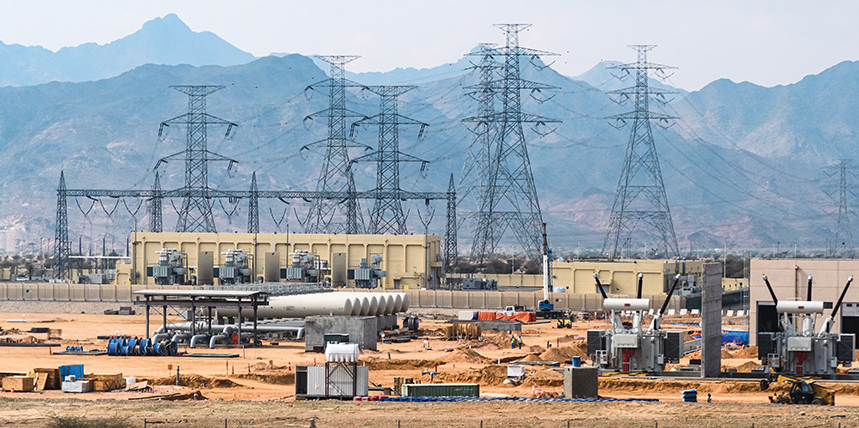Substations play a crucial role in the power system. Acting as the backbone of the grid, they are responsible for essential tasks including monitoring, controlling, and protecting power flow.[1] Over the years, the electrical industry has continuously worked to enhance and improve substation technologies, leading to the development of digital substations that integrate advanced communication and automation systems. These innovations improve efficiency, reliability, and real-time monitoring, ensuring a smarter and more resilient power grid.
SUBSTATION AUTOMATION SYSTEM FUNDAMENTALS
The fundamental principles governing modern substation automation systems (SAS) are the concepts of plug-and-play (PnP) and interoperability.[2] These principles ensure that the various components of an automation system can be easily integrated, replaced, or upgraded without disrupting the operation of the entire network. Standardized communication protocols such as IEC 61850 enable seamless integration and data exchange between devices. This enhances system flexibility, scalability, and operational efficiency.
Plug and Play
The plug-and-play capability of SAS allows for seamless integration of new devices into the system with minimal configuration and no significant downtime. This flexibility enables substations to quickly adopt the latest technologies and solutions, ensuring they remain adaptable to evolving requirements and can efficiently accommodate upgrades or expansions as needed. The plug-and-play feature significantly enhances the scalability and future-proofing of the automation system.
Interoperability
For SAS to operate effectively, it’s essential that various devices and systems from different manufacturers can communicate and function together seamlessly. This interoperability is achieved through the use of standardized communication protocols. The IEC 61850 standard is one such protocol that ensures devices from different vendors can share data and interact without compatibility issues, creating a unified and efficient system. Interoperability is critical for the flexibility and reliability of SAS, enabling smooth operation across various grid components.

SAS COMPONENTS
SAS contains several interconnected components that work together to monitor, control, and protect the flow of power. These key components enable substations to operate without human intervention, which helps reduce errors, improve system reliability, and ensure stable power flow. The following are key components that make up substation automation systems.
Intelligent Electronic Devices (IEDs)
In modern substations, traditional relays are being replaced by intelligent electronic devices (IEDs), which are central to the automation process. These devices are the backbone of the SAS, offering advanced functionality like real-time data monitoring, fault detection, protection, and control. IEDs can communicate directly with other components, process data locally, and act automatically, improving the overall efficiency, reliability, and speed of substation operations. The integration of IEDs ensures that substations can handle complex tasks with minimal human intervention while enhancing grid stability and energy flow, predicting demand, and preventing faults, making grids more resilient and cost-effective.[3]
Supervisory Control and Data Acquisition (SCADA)
Supervisory control and data acquisition (SCADA) is an integral part of modern SAS, providing real-time monitoring, control, and data analysis of power substations.[4] It enables operators to remotely manage equipment, ensuring efficient and reliable power distribution. SCADA systems collect data from field devices such as intelligent electronic devices (IEDs), facilitating functions such as fault detection, system optimization, and performance analysis. SCADA implementation in substations enhances grid reliability, reduces operating costs, and supports the integration of renewable energy sources by enabling rapid response to system disturbances.
Remote Terminal Unit (RTU)
A remote terminal unit (RTU) is a key component of SAS, enabling real-time data collection from devices such as circuit breakers and transformers. It transmits this data to a SCADA system, allowing operators to monitor performance, detect faults, and control equipment remotely. Modern RTUs support multiple communication protocols, ensuring compatibility and advanced features such as data logging and event reporting.
COMMUNICATION PROTOCOLS IN SAS
Effective communication protocols are essential in SAS to ensure seamless data exchange and interoperability among various devices. Three prominent protocols utilized in SAS are IEC 61850, DNP3, and Modbus. Each of these protocols offers distinct advantages and is selected based on specific requirements of the substation automation system, such as complexity, interoperability, and performance needs.
IEC 61850
IEC 61850 is a comprehensive standard designed for communication networks and systems in substations.[5] It facilitates high-speed data exchange and interoperability among intelligent electronic devices (IEDs) by employing object-oriented data models and services. This standard supports advanced functionalities such as generic object-oriented substation event (GOOSE) messaging and sampled values (SV), which enhance real-time communication and system reliability.
DNP3 Distributed Network Protocol
DNP3 is a robust communication protocol widely used in SCADA systems for electric utility automation.[6] DNP3 is designed to improve data transmission over long distances and supports features such as time-stamped data and event-driven reporting. DNP3 enhances interoperability between devices from various manufacturers and is known for its reliability in adverse environments.
Modbus
Modbus is a simple and widely adopted communication protocol that enables the transmission of information over serial lines between electronic devices.[7] It is used for connecting supervisory computers with remote terminal units (RTUs) in SCADA systems. Despite its simplicity, Modbus lacks some of the advanced features found in newer protocols, which may limit its applicability in complex substation automation scenarios.

IMPLEMENTATION OF SAS IN THE MIDDLE EAST
The Middle East is rapidly advancing in the adoption of SAS as part of its broader efforts to modernize power infrastructure, improve grid reliability, and support energy transition initiatives. Several countries in the region, particularly Saudi Arabia and Bahrain, have taken significant steps toward integrating SAS into their power networks.
Saudi Arabia’s SAS Implementation
Saudi Arabia has made substantial progress in automating its power distribution networks as part of its Vision 2030 energy transformation goals. According to the Saudi Minister of Energy, the country has achieved 32% of its SAS automation target, with plans to increase this to 40% by 2025.[8]
Saudi Arabia has also made significant strides in modernizing its power grid through substation automation and smart grid technologies. Since 2021, the country has installed over 11 million smart meters, allowing consumers to monitor their electricity consumption in real-time. To enhance grid management, the government plans to establish nine advanced control centers equipped with state-of-the-art monitoring and automation systems by 2026. Additionally, Saudi Arabia is expanding its transmission and distribution networks while adopting flexible transmission system technologies to improve energy exchange and reduce losses. Recognizing the challenges posed by renewable energy variability, the country is also investing in energy storage solutions, aiming to achieve a storage capacity of 48 GWh by 2030 to ensure grid stability and reliability.
These efforts position Saudi Arabia as a leader in SAS deployment, improving energy efficiency, grid resilience, and the integration of renewable energy sources.
Bahrain’s SAS Implementation
Bahrain has also made notable strides in modernizing its power infrastructure. The Electricity and Water Authority (EWA) has partnered with Hitachi Energy to implement SAS in three new 220 kV substations under a turnkey project.[9]
Bahrain’s implementation of SAS incorporates cutting-edge technologies to enhance grid reliability and efficiency. Gas-insulated switchgear (GIS) technology plays a crucial role in this transformation, offering high operational safety, a compact design, and resistance to environmental conditions, making it ideal for dense urban areas. To ensure seamless communication and system interoperability, the SAS is built on the IEC 61850 standard, which provides scalability, efficient data exchange, and improved coordination between control and protection devices.
Bahrain’s SAS implementation demonstrates the region’s commitment to future-proof automation solutions that improve grid stability, optimize operational efficiency, and enable seamless integration of renewable energy.
CHALLENGES OF DEVELOPING SAS IN THE MIDDLE EAST
SAS faces numerous challenges in the Middle East as it represents a relatively new technology being integrated into the region’s power grid.[10]
Integration Complexity
The integration of IEC 61850 with existing infrastructure, especially in legacy substations, presented challenges. Ensuring interoperability between old and new systems requires careful planning and modification of both hardware and software components.
Cybersecurity Concerns
With the increased digitization and networking of substations, securing the data and communication systems against cyber threats became a priority. Developing robust security protocols and systems to safeguard the infrastructure was a significant challenge.
Standardization Issues
While IEC 61850 is an international standard, its full adoption often faces barriers due to varying regional implementations and interpretations of the standard. Ensuring a uniform understanding of the standard and its application across various stakeholders, including equipment manufacturers and system integrators, posed difficulties.
Cost and Resource Constraints
The initial investment required for upgrading substations to comply with IEC 61850 standards, as well as the ongoing costs associated with maintaining and operating more advanced systems, were significant barriers. Budget constraints, particularly for public utility companies, created challenges in prioritizing these investments.
Skill Gaps
The adoption of advanced technologies and standards like IEC 61850 required a highly skilled workforce, but the lack of trained personnel and the need for continuous training programs were challenges in the region.
REFERENCES
Mohad Asim Aftab, et al. “IEC 61850-based Substation Automation System: A Survey.” International Journal of Electrical Power & Energy Systems Vol. 120 (2020): 106008.
X. Chen, H. Guo, and P. Crossley. “Interoperability Performance Assessment of Multivendor IEC61850 Process Bus,” IEEE Transactions on Power Delivery, Vol. 31, No. 4, pp. 1934–1944, Aug. 2016, doi: 10.1109/TPWRD.2015.2509644.
J. D. McDonald. “Substation Automation, IED Integration, and Availability of Information,” IEEE Power and Energy Magazine, Vol. 1, No. 2, pp. 22–31, March-April 2003, doi: 10.1109/MPAE.2003.1192023.
D. Patel, K. Chauhan, A. Bhut, J. Brahmbhatt, and S. Dalia. Substation Automation Using PLC and Scada,” International Journal of Emerging Technologies and Innovative Research (www.jetir.org), ISSN:2349-5162, Vol. 5, Issue 11, pp. 923–930, November 2018, Accessed at http://www.jetir.org/papers/JETIRK006140.pdf.
S. Kumar, A. Abu-Siada, N. Das, S. Islam. Review of the Legacy and Future of IEC 61850 Protocols Encompassing Substation Automation System,” Electronics 2023, 12(15), 3345; https://doi.org/10.3390/electronics12153345.
J. Horalek, J. Matyska, and V. Sobeslav, “Communication Protocols in Substation Automation and IEC 61850-based Proposal,” 2013 IEEE 14th International Symposium on Computational Intelligence and Informatics (CINTI), Budapest, Hungary, 2013, pp. 321–326, doi: 10.1109/CINTI.2013.6705214.
J. Zhang and C.A. Gunter. IEC 61850 Communication Networks and Systems in Substations: An Overview of Computer Science. University of Illinois Security Lab, April 2014. Accessed at https://www.researchgate.net/publication/229008227_IEC_61850-Communication_Networks_and_Systems_in_Substations_An_Overview_of_Computer_Science.
“AI-Powered Energy: Saudi Arabia’s Automated Future” (blog), Saudi Arabia Energy by Eurogroup Consulting. Accessed at https://saudienergyconsulting.com/insights/articles/ai-powered-energy-saudi-arabias-automated-future.
IEC 61850 compliant substation automation systems deployed in Bahrain” (blog), Hitachi Energy. Accessed at https://www.hitachienergy.com/fr/fr/news-and-events/customer-success-stories/iec-61850-compliant-substation-automation-systems-deployed-in-bahrain.
S. A. Obaidli, et al. “IEC 61850 Beyond Compliance: A Case Study of Modernizing Automation Systems in Transmission Power Substations in Emirate of Dubai towards Smart Grid,” 2017 Saudi Arabia Smart Grid (SASG), Jeddah, Saudi Arabia, 2017, pp. 1–9.

Khaled Shadi Morshed received his BEng degree in electrical engineering from Balqa’ University, Jordan. He is currently working as an Electrical Engineer at Commissioning Services International (CSI), where he is involved in testing, commissioning, and power system analysis. Khaled is experienced in electrical testing, with a solid background in performing diagnostics and evaluations to ensure the reliability and safety of power systems.
